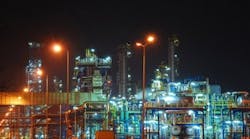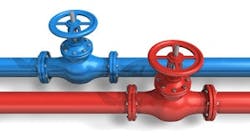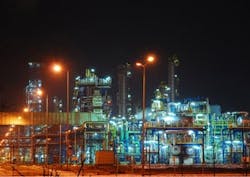In brief:
- The introduction of improved corrosion management practices has become a central strategy for plants.
- Plant operations must always keep a sharp eye on machinery to identify the presence of corrosion on metal surfaces and take just-in-time remedial action.
- Whether applying epoxy coatings for resistance to corrosion/chemicals or to serve as patches or other remedial repair solutions, proper preparation of a metal substrate surface can make or break the outcome.
According to a 2002 federal study, “Corrosion Costs and Preventive Strategies in the United States,” initiated by NACE International, the Corrosion Society (www.nace.org), the estimated annual corrosion-related costs to U.S. production and manufacturing operations is $17.6 billion. Chemical attacks on machinery are all too common, especially in harsh operating conditions, and abrasion persists from a variety of causes.
The introduction of improved corrosion management practices has subsequently become a central strategy for plants in getting a handle on these problems before the damage has been done. Epoxy coatings can be applied to the surfaces of a wide range of equipment from engines, fans, blowers, and compressors to valves, pipes, pumps, and handling machinery. They can protect against harsh chemicals and elements as a preventive measure or provide repair solutions as patch materials when metal surfaces show telltale signs of distress or deterioration.
Telltale signs of corrosion
[pullquote]Plant operations must always keep a sharp eye on machinery to identify the presence of corrosion on metal surfaces and take just-in-time remedial action. Some of the common telltale manifestations of corrosion include fretting corrosion (visible through pits, grooves, or debris relating to oxidation, occurring at the asperities, or peaks, of contact surfaces), galvanic corrosion (pits or holes resulting from dissimilar metal, where one metal corrodes faster than it would alone, while the second corrodes more slowly than it would alone), uniform corrosion (characterized by corrosive attack proceeding evenly over the entire surface area or a large fraction of the total area), pitting corrosion (an extremely localized form leading to the creation of small holes in metal), and others that can result in cracking, severe loss of ductility, and increased residual tensile stresses.
Epoxy, or polyepoxide, serves as a thermosetting polymer that initiates polymerization, or curing, when mixed with a hardener. The polymer itself is gleaned from a chemical reaction, usually between epichlorohydrin and bisphenol-A, which results in an epoxy resin for use as a coating.
Epoxies usually can be modified with the addition of mineral fillers, stabilizers, viscosity reducers, colorants, thickeners, accelerators, or adhesion promoters. Ultimately, formulations can be tailored for an application’s particular demands.
Epoxy coatings carry advantages that can advance specific performance objectives.
Figure 1. Color-coated epoxies give pipes better resistance to corrosion.
Two-component epoxy systems consist of a resin and a hardener mixed prior to application and similarly formulated to offer a wide range of mechanical, thermal, and optical properties. While mix ratios will differ, these systems provide the capability to cure quickly at ambient temperatures or at elevated temperatures for faster cures. Also available are two-part systems that can only be cured upon exposure to heat. In addition to corrosion resistance, these coatings are chemically formulated to resist exposure to machinery vibration and shock.
Along with chemical resistance, they exhibit high tensile modulus, compressive strength, dimensional stability, and temperature resistance properties. These products are comprised of 100% solids, contain no solvents, have low shrinkage, and are available in a wide range of colors (Figure 1 and Figure 2). All these and other properties and characteristics make epoxy coatings, formulated consistent with application requirements, suited for metal components to safeguard against corrosion, chemicals, and the daily wear and tear that can lead to surface deterioration.
Proper surface preparation
Figure 2. Technologically advanced coatings have been formulated to meet the demanding needs of industry, including petrochemical plants.
Whether applying epoxy coatings for resistance to corrosion/chemicals or to serve as patches or other remedial repair solutions, proper preparation of a metal substrate surface can make or break the outcome. The surfaces should be sandblasted to provide adequate roughening for good bond strength, and the parts should be free from oils, greases, paint, oxide films, dust, mold release agents, rust inhibitors, and other contaminants.
The three primary methods for removing surface contaminants include degreasing (with solvents such as acetone, isopropanol, or proprietary cleaners, including hot alkali solutions), chemical cleaning, and abrasion. The particular type of metal substrate will govern which method is best suited for the preparation of the surface. The methods may be used alone or sometimes in combination for greater effectiveness, depending on the degree of surface cleanliness required.
{pb}In some cases, vapor honing may be required to help remove mill scale, oxide films, and certain anti-rust treatments. Chemical cleaning, such as etching, is popular for preparing metals and, where applicable, provides a superior surface for adhesion.
When using chemicals, all appropriate federal, state, and local regulations for safe handling and disposal should always be followed and appropriate care should be taken during necessary surface preparation procedures.
| Michael Wollman is application engineer at Master Bond (www.masterbond.com). Contact him at (201) 343-8983 or [email protected]. |
A simple yet effective test to determine surface cleanliness is to place a few drops of water on the areas to be bonded. Parts are sufficiently clean if the water spreads to cover the area with a continuous film. If water beading occurs, the conventional solvent (degreasing) operation will usually be sufficient for cleaning.
Adhesive primers can be applied to freshly cleaned metal surfaces to avoid recontamination during storage or production delays, but they are not necessary if coatings will be applied to surfaces immediately after cleaning.
Questions to consider
When evaluating epoxies for an application, the following basic tips can help steer the way toward proper selection. Specifically formulated grades have been developed as solutions for different application requirements, and custom formulations always are an option. Given the many variations and potential solutions, users can more fully equip themselves to arrive at the suitable choice by considering some basic questions relative to the intended application and desired formulation properties.
- Will the coating ideally suit the environmental/exposure conditions to be encountered?
- Will the coating be exposed to liquid immersion or vapors?
- Will the coating be exposed to high temperatures or thermal cycling/shock?
- Will the coating be exposed to other forces such as vibration and mechanical shock?
- Will recoating be required and within what time frame?
- Will the coating design match the application technique (spraying, brushing, roller coating, flow coating, or robotic dispensing)?


